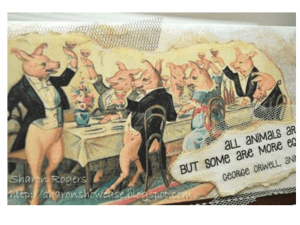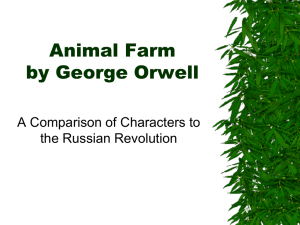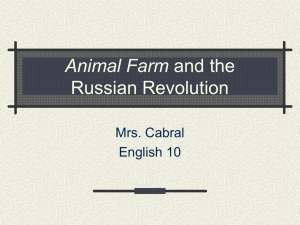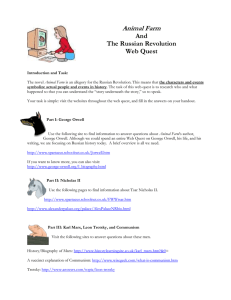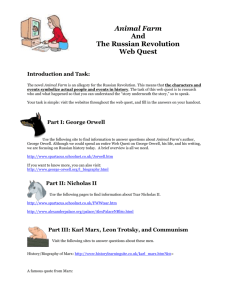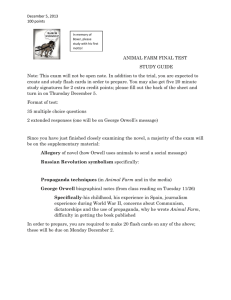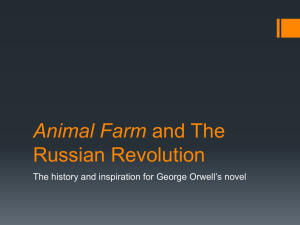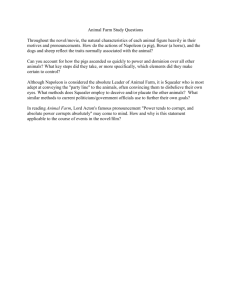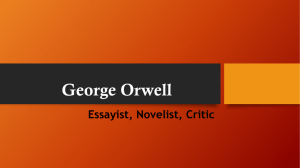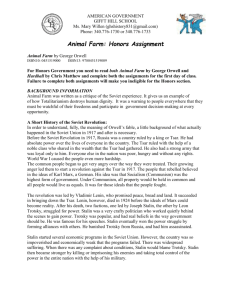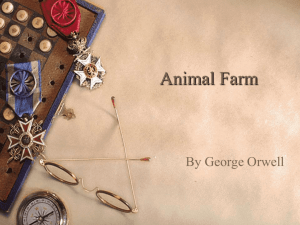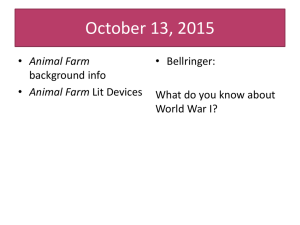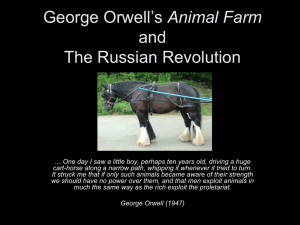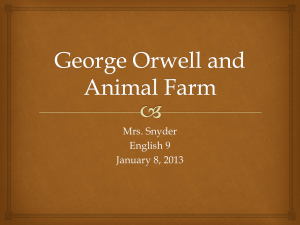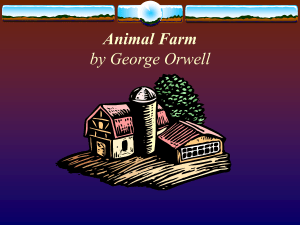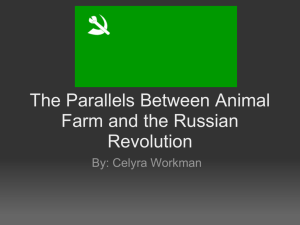Animal Farm George Orwell
advertisement
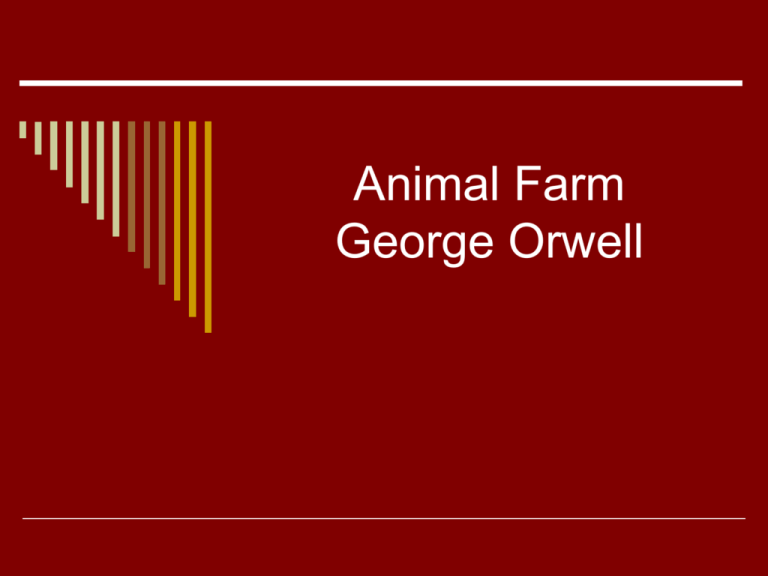
Animal Farm George Orwell Vocabulary for Animal Farm Due Jan. 7 Test Jan. 8 Ensconced Preeminent Obstinate Cryptic Indefatigable Irrepressible Ignominious Sordid Malignity Machinations Benevolent Vivacious Tractable Conciliatory Superannuated Maxim Cynical Posthumously Pretext Intermediary Retribution Categorically Incumbent Capitulated Censured Plot and Setting Animal Farm is a political novel set on a British farm where barnyard animals successfully revolt against a human master who has exploited them. Novel Structure To convey his political message, Orwell employs the literary forms of allegory, satire, and fable. An allegory is a story that can be read on two distinct levels. Many of the characters in the novel represent the leaders of the Russian Revolution. A satire uses ridicule to make certain people, events, or institutions appear foolish. A fable is a brief, often humorous, tale that presents a moral or message. Conflict External Conflict – The narrative is driven by the conflict dealing with the animals, such as the disagreements between Napoleon and Snowball, between the animals and the humans, and between the animals and the elements. Internal Conflict – One of Orwell’s points is the lack of internal conflict because the animals are so easily swayed by Squealer. Characters Old Major Mollie Napoleon Muriel Snowball Moses Squealer Mr. Jones Boxer Mr. Whymper Clover Mr. Fredrick Benjamin Mr. Pilkington Themes The corruptive nature of power – Orwell shows how both the leaders and the followers in a society can act in ways that destroy freedom and equality. The oppressed tightening the noose of oppression – Orwell illustrates the limiting of individual freedom through the ignorance, inertia, or misplaced loyalty of the animals. Tyranny distorting history and language – Orwell shows how propaganda techniques like those practiced by Squealer and accepted by the animals are used to justify a tyrant's decisions and actions. Historical Context – Karl Marx Karl Marx was born in Prussia in 1818. He was a journalist whose unpopular views forced him to leave his country. Eventually, he and Friedrich Engels published the Communist Manifesto, a pamphlet outlining Marx’s ideas about government and economics, including his belief that pure communism would be the inevitable outcome of human history. Historical Context In Russia, by the early 1900s, the writings of Karl Marx, increasing economic hardship, and the injustices of the czars inspired widespread revolt and led to the Russian Revolution. Czar Nicholas II was overthrown and later executed with his wife and children. A provisional government of revolutionaries assumed leadership. Seven months later, the Bolsheviks, led by Vladimir Lenin, overthrew the provisional government. (the October Revolution) The Bolsheviks renamed themselves the Russian Communist Party and became known as the Reds. Historical Context After Lenin died in 1924, a power struggle began for control of the Communist Party between two major contenders. Leon Trotsky was a talented party organizer who had played an important role in the Russian Revolution. Joseph Stalin was the secretary general of the Communist Party and favored a modified form of Marxism. Historical Context Following a struggle marked by assassination and betrayal, Trotsky was exiled in 1928. Stalin became dictator of the Soviet Union. Later his agents assassinated Trotsky in Mexico. Stalin instituted a series of Five – Year Plans to increase economic growth, but goods decreased. Totalitarianism – a form of government with a strong central rule that attempts to control individuals by means of coercion and repression. Who is Who and What is What Mankind Mr. Jones – Czar Nicholas II Mrs. Jones – Alexandra (Nicholas’s wife) Mr. Pilkington – Leader of England Mr. Frederick – Leader of Germany (many references to Hitler) Mr. Whymper – Capitalist who did business with the Soviet Union. Who is Who and What is What Animals Napoleon – Joseph Stalin Squealer – Russian Media Snowball – Leon Trotsky Old Major – Karl Marx/Vladimir Lenin Boxer – Working Class Mollie – Upper Class Dogs – Military/Police Moses – Russian Orthodox Church Hens – Peasant Farmers Sheep – Masses following Stalin Who is Who and What is What Places Animal Farm – The Soviet Union Manor Farm – Russia Foxwood – England Pinchfield – Germany Willingdon – Europe England – Represents the entire world Farmhouse – The Kremlin Sugar Candy Mountain - Heaven Who is Who and What is What Things and Events Animalism – Communism Animal Committees – Soviet Committees Beast of England – Ideology of Communism Windmill – Stalin’s Five – Year Plans The Animal Revolt – Russian Revolution Battle of Cowshed – Red October The Hens’ revolt – Ukrainian peasants’ bitter resistance to collective farming. Destruction of the Windmill – Failure of Stalin’s plans Selling of the wood to Frederick – Nazi-Soviet pact Battle of the Windmill – Battle of Stalingrad (German invasion of Russia during World War II)
